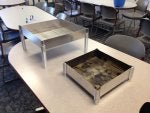Hello,
You might have seen my other post asking about fire pan sizing, this time I am looking for opinions. For my CU Freshmen Engineering Projects course, my group designed a light weight and breakdown fire pan. We are presenting at the University of Colorado Engineering Design Expo on this Saturday, April 28th.
The main features of our pan are:
From the pictures below you can see how small the pan packs up. The 300in^2 packs to about 3.5x18x6.25 and the 12x12 is about 3.5x12.5x6.25. The pan separates into 15 pieces and could be carried by different people (mainly for kyakers) or separated to fit where it can when rigging.
Do note that in the photos the 12x12 fire pan is using our prototype fittings and are longer (4"3/4) than the final design fittings (3"1/16). This is only because we only have one set of the final design fittings, the 12x12 will have the short fittings.
We are using aluminum for everything except for the base which is steel (stainless could be used but more expensive) to keep the weight down. The risers are SCH40 pipe 6061-T6, the fittings were created using a lathe and 4-axis CNC out of 1"3/8 solid round 6061-T6, the side plates are bent 5052 aluminum (6000 series doesn't bend), and the base is A366 steel sheet with two of the three plates (300in^2 version) jogged to provide an overlap. With this the 12x12 weighs about 6.75lbs and the 300in^2 weighs under 9lbs.
The fire pans are strong and durable as well. In a couple of the pictures you can see a bucket full of water in the pans. This is a 2.5 gallon bucket (about 20lbs) and placed directly in the center with no issues. You could put more depending on the bucket diameters but can easily support 3 full 2.5 gallon buckets.
One of my favorite features would be the modular ability. You could easily have different (and custom) sizes for the fire pan based on your trip necessities without increasing your cost drastically. Lets say you want a 17x24 or 17x36 all you would need is two additional side plates and one or three bottom plates.
While this doesn't have a cooking surface it is designed for one. The scope and time constraints of the class kept that from this design. For the cooking surface there will be 2 more fittings that get inverted and stacked on top of opposing corners. Then you'll attach 8" pipes to the inverted pieces. The pipe will have about 5 holes along the length for temperature control. The cooking surface will have fittings on two corners that slide over the pipe and get pinned to the correct height.
~~~~~~~~~~~~~~~~~~~~~~~~~~~~~~~~~~~~~~~~~~~~~~
You might have seen my other post asking about fire pan sizing, this time I am looking for opinions. For my CU Freshmen Engineering Projects course, my group designed a light weight and breakdown fire pan. We are presenting at the University of Colorado Engineering Design Expo on this Saturday, April 28th.
The main features of our pan are:
- Competitive price (we are thinking about $125/$150 retail)
- Breakdown & extremely packable
- Quick & easy to assemble
- Light weight
- Modular
From the pictures below you can see how small the pan packs up. The 300in^2 packs to about 3.5x18x6.25 and the 12x12 is about 3.5x12.5x6.25. The pan separates into 15 pieces and could be carried by different people (mainly for kyakers) or separated to fit where it can when rigging.
Do note that in the photos the 12x12 fire pan is using our prototype fittings and are longer (4"3/4) than the final design fittings (3"1/16). This is only because we only have one set of the final design fittings, the 12x12 will have the short fittings.
We are using aluminum for everything except for the base which is steel (stainless could be used but more expensive) to keep the weight down. The risers are SCH40 pipe 6061-T6, the fittings were created using a lathe and 4-axis CNC out of 1"3/8 solid round 6061-T6, the side plates are bent 5052 aluminum (6000 series doesn't bend), and the base is A366 steel sheet with two of the three plates (300in^2 version) jogged to provide an overlap. With this the 12x12 weighs about 6.75lbs and the 300in^2 weighs under 9lbs.
The fire pans are strong and durable as well. In a couple of the pictures you can see a bucket full of water in the pans. This is a 2.5 gallon bucket (about 20lbs) and placed directly in the center with no issues. You could put more depending on the bucket diameters but can easily support 3 full 2.5 gallon buckets.
One of my favorite features would be the modular ability. You could easily have different (and custom) sizes for the fire pan based on your trip necessities without increasing your cost drastically. Lets say you want a 17x24 or 17x36 all you would need is two additional side plates and one or three bottom plates.
While this doesn't have a cooking surface it is designed for one. The scope and time constraints of the class kept that from this design. For the cooking surface there will be 2 more fittings that get inverted and stacked on top of opposing corners. Then you'll attach 8" pipes to the inverted pieces. The pipe will have about 5 holes along the length for temperature control. The cooking surface will have fittings on two corners that slide over the pipe and get pinned to the correct height.
~~~~~~~~~~~~~~~~~~~~~~~~~~~~~~~~~~~~~~~~~~~~~~
Now for your help. Can you provide your feedback that we can use in our presentation? We want the good and the bad.


















